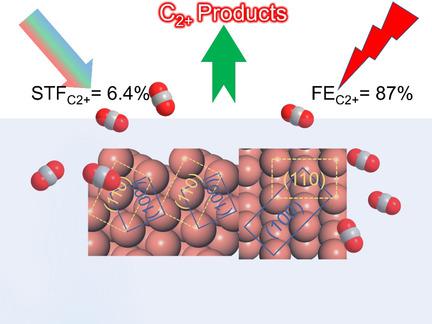当前位置:
X-MOL 学术
›
Angew. Chem. Int. Ed.
›
论文详情
Our official English website, www.x-mol.net, welcomes your
feedback! (Note: you will need to create a separate account there.)
Coupling of Cu(100) and (110) Facets Promotes Carbon Dioxide Conversion to Hydrocarbons and Alcohols
Angewandte Chemie International Edition ( IF 16.1 ) Pub Date : 2020-11-24 , DOI: 10.1002/anie.202015159 Dazhong Zhong 1, 2 , Zhi‐Jian Zhao 1 , Qiang Zhao 2 , Dongfang Cheng 1 , Bin Liu 1 , Gong Zhang 1 , Wanyu Deng 1 , Hao Dong 1 , Lei Zhang 1 , Jingkun Li 1 , Jinping Li 2 , Jinlong Gong 1, 3
Angewandte Chemie International Edition ( IF 16.1 ) Pub Date : 2020-11-24 , DOI: 10.1002/anie.202015159 Dazhong Zhong 1, 2 , Zhi‐Jian Zhao 1 , Qiang Zhao 2 , Dongfang Cheng 1 , Bin Liu 1 , Gong Zhang 1 , Wanyu Deng 1 , Hao Dong 1 , Lei Zhang 1 , Jingkun Li 1 , Jinping Li 2 , Jinlong Gong 1, 3
Affiliation

|
Copper can efficiently electro‐catalyze carbon dioxide reduction to C2+ products (C2H4, C2H5OH, n‐propanol). However, the correlation between the activity and active sites remains ambiguous, impeding further improvements in their performance. The facet effect of copper crystals to promote CO adsorption and C−C coupling and consequently yield a superior selectivity for C2+ products is described. We achieve a high Faradaic efficiency (FE) of 87 % and a large partial current density of 217 mA cm−2 toward C2+ products on Cu(OH)2‐D at only −0.54 V versus the reversible hydrogen electrode in a flow‐cell electrolyzer. With further coupled to a Si solar cell, record‐high solar conversion efficiencies of 4.47 % and 6.4 % are achieved for C2H4 and C2+ products, respectively. This study provides an in‐depth understanding of the selective formation of C2+ products on Cu and paves the way for the practical application of electrocatalytic or solar‐driven CO2 reduction.
中文翻译:

Cu(100)和(110)面的耦合促进二氧化碳转化为碳氢化合物和醇
铜可以有效地电催化将二氧化碳还原为C 2+产物(C 2 H 4,C 2 H 5 OH,正丙醇)。但是,活动和活动站点之间的相关性仍然不明确,从而阻碍了其性能的进一步提高。描述了铜晶体促进CO吸附和CC耦合并因此产生对C 2+产物的优异选择性的刻面效应。我们对Cu(OH)2上的C 2+产品实现了87%的高法拉第效率(FE)和217 mA cm -2的大分流密度‐D仅在−0.54 V时相对于流通池电解槽中的可逆氢电极。进一步与Si太阳能电池耦合,C 2 H 4和C 2+产品的太阳能转换效率达到了创纪录的4.47%和6.4%。这项研究提供了对Cu上C 2+产物选择性形成的深入了解,并为电催化或太阳能驱动的CO 2还原的实际应用铺平了道路。
更新日期:2020-11-24
中文翻译:

Cu(100)和(110)面的耦合促进二氧化碳转化为碳氢化合物和醇
铜可以有效地电催化将二氧化碳还原为C 2+产物(C 2 H 4,C 2 H 5 OH,正丙醇)。但是,活动和活动站点之间的相关性仍然不明确,从而阻碍了其性能的进一步提高。描述了铜晶体促进CO吸附和CC耦合并因此产生对C 2+产物的优异选择性的刻面效应。我们对Cu(OH)2上的C 2+产品实现了87%的高法拉第效率(FE)和217 mA cm -2的大分流密度‐D仅在−0.54 V时相对于流通池电解槽中的可逆氢电极。进一步与Si太阳能电池耦合,C 2 H 4和C 2+产品的太阳能转换效率达到了创纪录的4.47%和6.4%。这项研究提供了对Cu上C 2+产物选择性形成的深入了解,并为电催化或太阳能驱动的CO 2还原的实际应用铺平了道路。









































 京公网安备 11010802027423号
京公网安备 11010802027423号